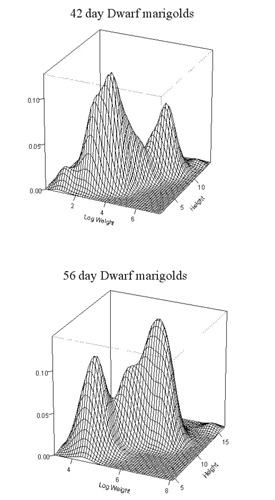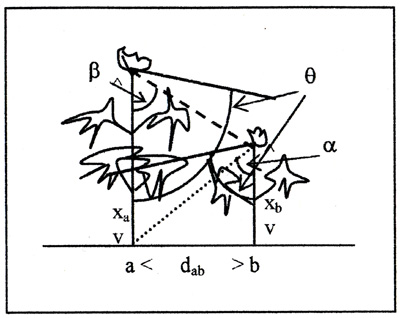Ms Shawn Behling is currently working with Arabidopsis thalinia to define competition in terms of leaf angle, lamina to petiole area, shape
differences and size inequalities that take place in individuals as a community
develops.work

View from above an experimental planting of Arabidopsis showing individual plants expanding. and the leaves of some plants overlapping the space occupied by neighbors

Although bimodal size distributions have been reported
by a considerable number of authors, and for a range of species, their
conclusions have been based on visual inspection of histograms which has
lead to dispute as to whether or not bimodal distributions really exist. We
have two results from recent work:
(1) For analysis of stand structure
plant size is best represented as a bivariate quantity of plant height
and plant weight. This reflects the important processes of growth in height,
which determines canopy position, and the amount of folige of a plant,
which affects its growth capacity.
(2) When this bivariate
distribution is used then the existence, or not, of bimodality can be
identified by fitting mixtures of distributions. This method,
with programs and examples, is discussed on our biometrics page.
The upper graph on the left shows a kernel density estimate of the bivariate [abscissa natural logarithm of vegetative weight (dry mgs); ordinate, height(cms)] distribution of surviving plants after 42 days, 2 cm triangular lattice. There are two modes in the distribution with more plants in the small size sub-population. The lower graph shows the same distribution but for pants surviving to 56 days, note the change in scale of the abscissa. At 56 day substantial mortality has occurred and the large plant size modes has most plants.
A question of interest about canopy competition is whether
smaller plants may have some effect on the growth of larger ones. If large
plants reduce the growth of smaller ones, which is expected, but there
is no reciprocal effect of small on large, then competition can be termed
"one-sided". On the other hand if small plants do
have some effect on the growth of larger ones, but it is less than the
effect of large on small then competition can be call "assymmetric".
Turley & Ford (2009)
fit models of these two types of competition to developing
stands of dwarf marigolds. They find that competition is predominately
"one-sided" with only a possibility of "assymmetric"
competition occurring at the earliest stage of stand development.
Of course this result depends on how "large" and "small"
plants are classified. In closely grown stands that have bimodal
plant size frequency distributions as shown in the above graph there is
clearly a large difference between "large" and "small"
sub-populations. However, within the "large" plant
sub-population there is likely competition between plants depending on
their proximity to each other.

Diagrammatic representation of assessed competition models. The left hand plant, represents the larger of a pair of competing plants. It affects the smaller individual according to the ratio of the angles beta/theta, where theta is esimated as a competition factor for the whole stand. In assymmetric competition the smaller plant is allowed to influence the larger one by reducing its growth by alpha/theta.